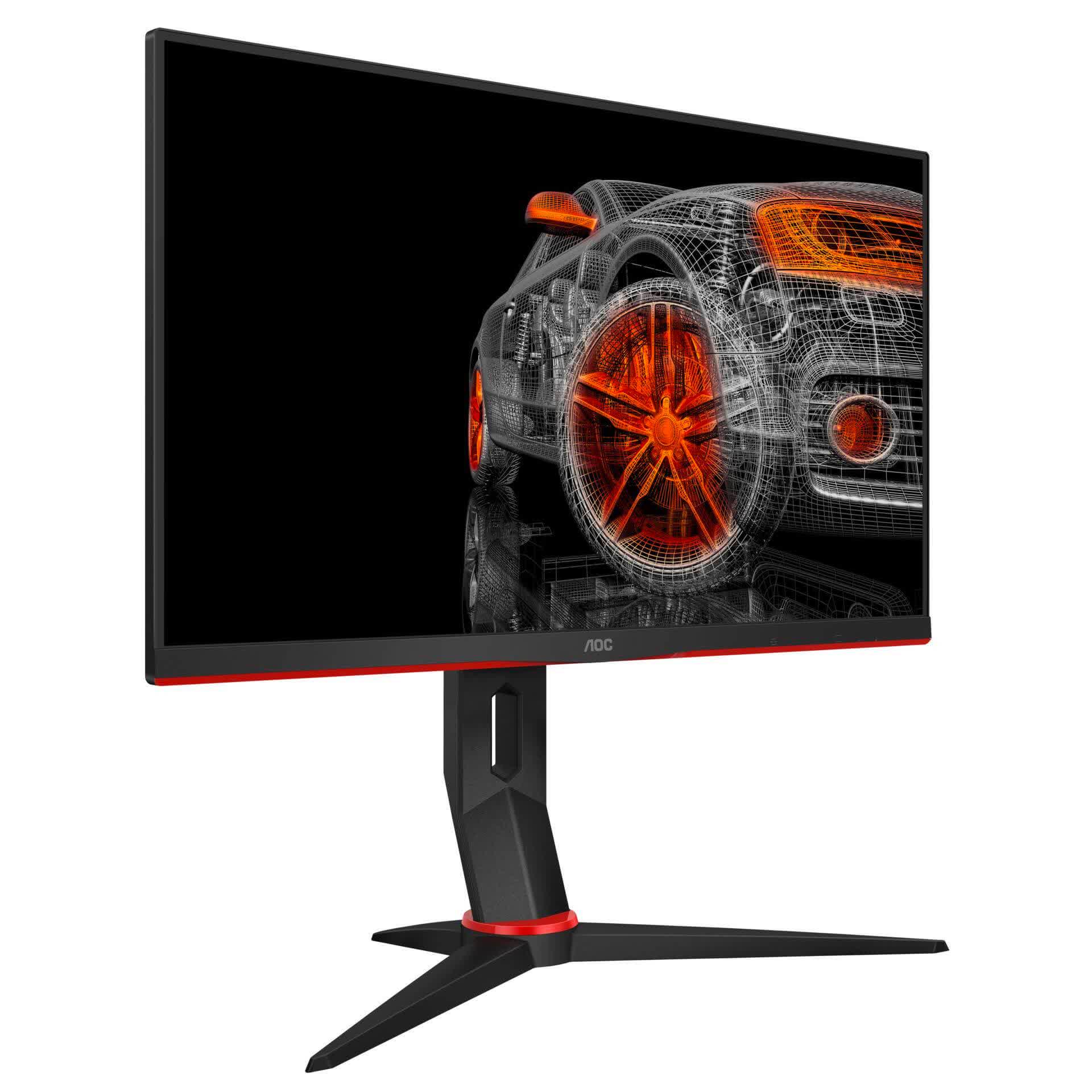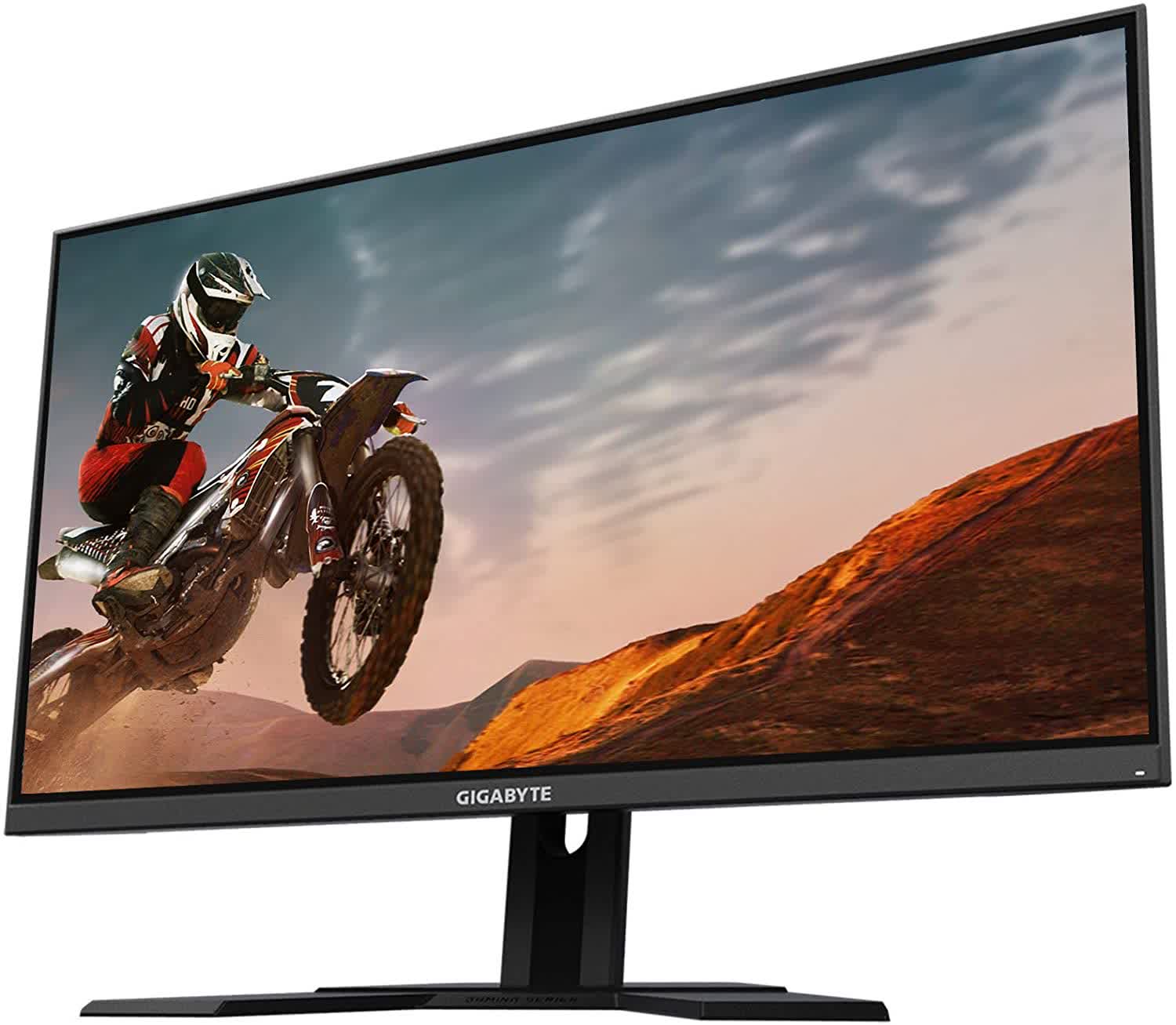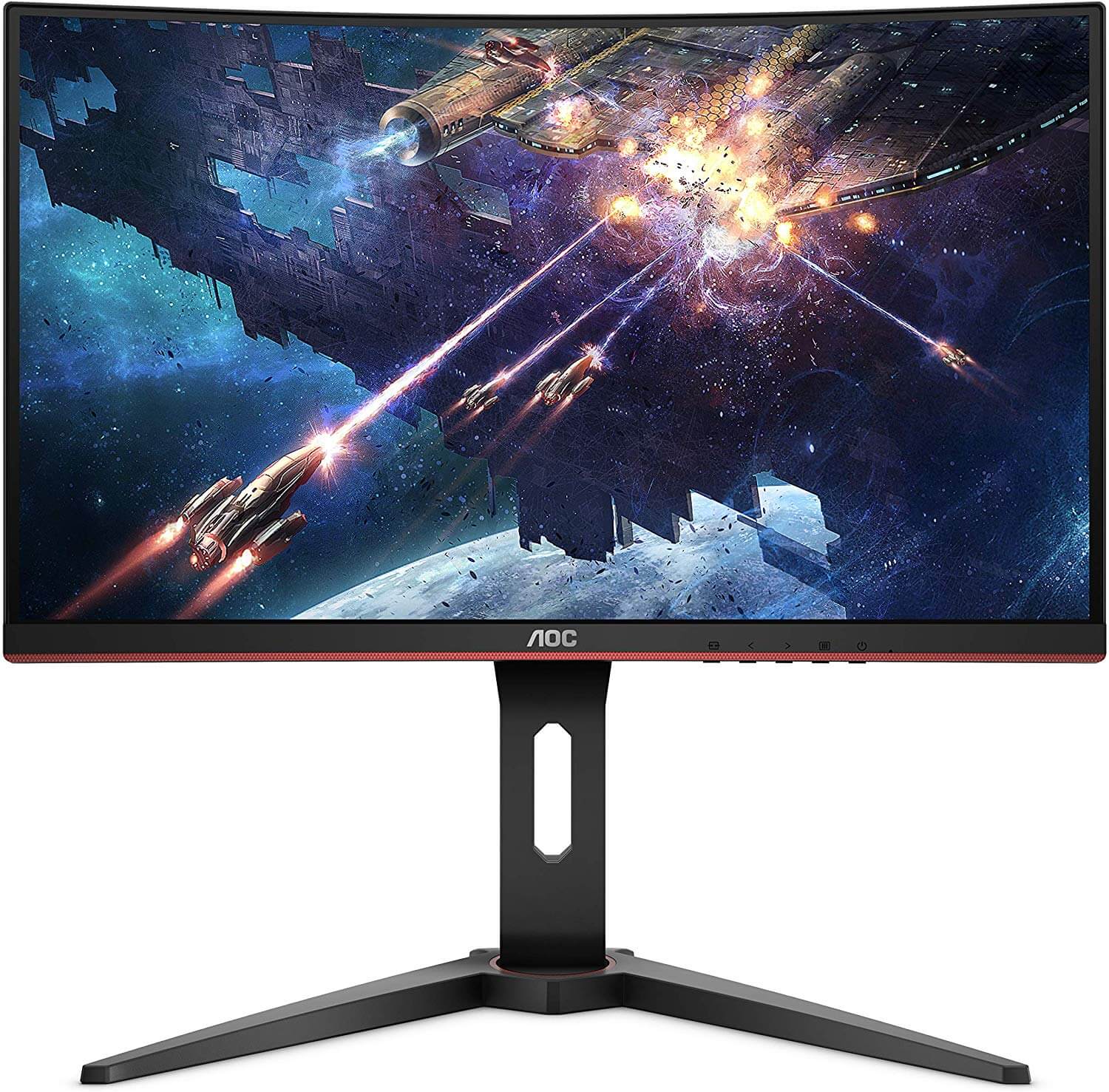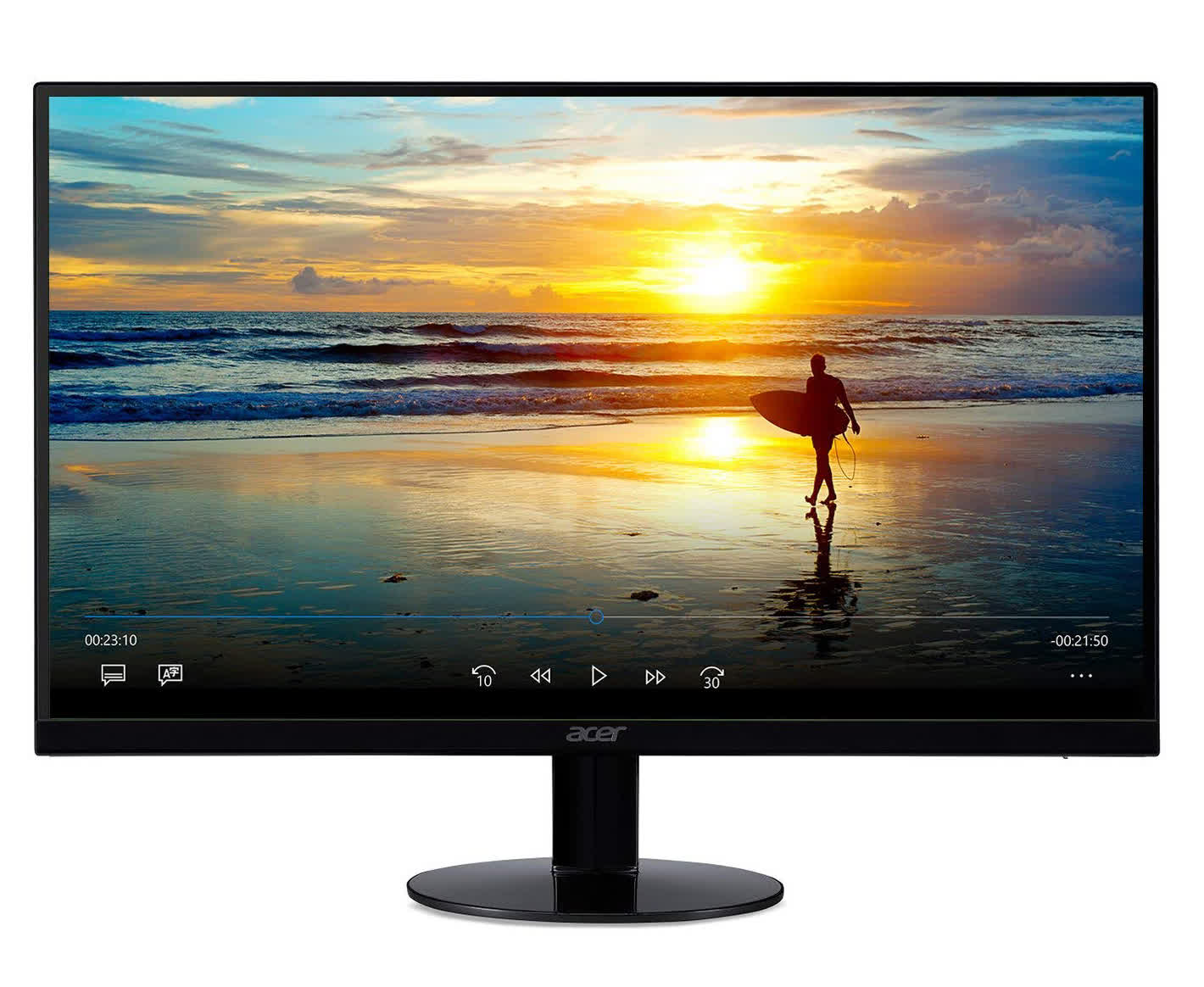If you’re tight on cash but want a really good monitor, this is the article for you.
For putting together this buying guide we narrowed down our options to displays that give you the best experience for the lowest possible price. Most of these picks end up squarely as the ‘best bang for buck’ option, while we also evaluated some outright cheap options that will get mentioned where it makes the most sense.
Recommendations are divided in four categories, covering 1080p monitors, 1440p monitors, ultrawide displays, and dirt cheap sub-$100 products. You’ll notice that we don’t have a 4K monitor category. We looked at some of the budget 4K monitor options on the market right now and felt that none of them were worth recommending for gaming.
You can get some cheap 4K monitors these days, spending around $300 will get you a 28-inch 4K 60Hz IPS unit, but with a low refresh rate and mediocre adaptive sync implementation, we feel gamers are better off choosing something from our picks in the best 1440p monitor category instead. Affordable 4K units are fine for productivity work, but for gaming you simply won’t do well with those.
- Best 1080p Budget
- Best 1440p Budget
- Budget Ultrawide
- Dirt-Cheap Monitor
Best 1080p Budget Gaming
AOC 24G2 24″

These days monitors that top out at 144 to 165Hz are more medium-refresh rate, given the prevalence of 240Hz and above especially at 1080p. This is by far the most popular category for 1080p buyers, and there’s a serious wealth of options to choose from, which makes picking one out quite tricky. For this reason, we’re splitting this category in two brackets: the best quality IPS offering and the more budget oriented monitors for cash strapped gamers.
It should be noted that the best value option will vary based on your location and local pricing. And while this is usually the case, today there’s more volatility in the monitor market and supply issues are affecting displays, just not to the same extent as other PC components.
For most people, our top recommendation for 1080p 144Hz is the AOC 24G2. The 24G2, and the larger 27-inch variant (27G2), include an IPS panel, adaptive sync and a refresh rate that tops out at 144Hz. We were impressed with the build quality that includes features like a height adjustable stand, not often found on more budget oriented displays. But one of the key features, especially of the newer 2020 variant, is response time performance, which is very strong and in some ways as good as higher-end 1440p monitors. The 24G2 is among the best 1080p IPS monitors we’ve tested for motion clarity, which makes it a great choice for gaming.

At some point we hesitated to keep recommending the 24G2, given that AOC silently changed the panel last year, without changing the name or informing customers. However, we bought the new variant and found that while it doesn’t perform the same as the older variant, in some ways it’s actually superior. Other aspects are solid as well, including its wide gamut support and contrast ratio, however the older 2019 variant is superior for contrast ratio and factory calibration, so it may be worth hunting the older model if you need those features. But in general this is a versatile monitor with a nice set of features and great performance at this price.
Two Alternatives: BenQ & MSI
If you are unable to find the AOC, there’s a great alternative in the BenQ EX2510. While usually more expensive than the 24G2 for a similar level of performance, if pricing is similar to the 24G2 in your region then it’s also a good choice.Another option worth considering is the MSI Optix G242. It uses the same panel as the newer AOC 24G2 suggesting that performance should be similar in terms of response times and color performance, although MSI will use different overdrive settings. Based on previous MSI monitors that we have reviewed, they are competent at getting decent results from a given panel.
Going Larger or Cheaper
If you want something larger, in the 27-inch range, in addition to the AOC 27G2 we’d also consider Gigabyte’s G27F and M27F, which offer a classic 1080p 144Hz IPS experience. Gigabyte are mostly focusing on 27-inch 1080p monitors in their line-up, and these two options often have competitive pricing in the $220 range.

While products like the AOC 24G2 and MSI G242 can be quite affordable, there are cheaper options also worth considering. Both the Pixio PX248 Prime and the Asus VP249QGR are worthy affordable options. We’ve tested both the PX248 Prime and the Prime S version, and honestly we’d save the money to get the slightly cheaper non-S model, which retails for just $170. Response times are similar to the older version of the 24G2, and while factory calibration could use some work, it’s an acceptable panel overall.
What Not to Buy
What we’d steer clear from at the moment are 1080p VA monitors. The value proposition isn’t there compared to IPS, especially as most of these VAs use fairly mediocre panels with issues like dark level smearing and slow response times. The Asus VG24VQ, for example, is a particularly popular option, but it costs $180 – only $10 less than a decent IPS like the MSI 24G2 and $10 more than cheaper options like Asus’ own VP249QGR.
As for 1080p 144Hz TN panels, again the value proposition isn’t great. You can find some monitors with these specs below $150, like the Acer KG241QP, but many options we feel are overpriced. The LG 24GL600F was a great budget option on release, but the price squeeze on IPS places it around the same mark as budget IPS alternatives. You may want to consider one for backlight strobing technology, although finding a panel that does this well at 144Hz at an acceptable price is difficult.
Among gamers 1080p monitors are still extremely popular. While some will no doubt look to upgrade to a higher resolution with their next monitor purchase, if you only have around $200 to spend, you’ll get by far the best experience going with something 1080p. There are several 1080p monitor types on the market, and we’ve been recommending VA or TN panels in this category depending on where pricing sits at any given time. But in 2020, with the release of several really high quality yet affordable IPS options, we believe the best bang for buck right now lies with this often premium monitor technology.
Currently the best budget 1080p monitor is the AOC 24G2. Not only is this the best 1080p 144Hz gaming monitor on the market overall, but thanks to a low $180 price, we also believe it’s the best bang for buck 1080p monitor you can get.
The 24G2 uses a 24-inch flat 1080p 144Hz IPS panel with adaptive sync and low frame rate compensation. The gaming experience is simply great due to a combination of factors. We get a high refresh rate, great adaptive sync implementation that works flawlessly with AMD or Nvidia GPUs, and fast response times due to its use of IPS technology.
A 5ms grey to grey average using its optimal overdrive settings is a good bit faster than equivalent VA panels, and approaches some TNs that typically retail for around the same price. Throw in a backlight strobing mode and the 24G2 delivers very good motion handling, which makes it ideal for fast paced gaming.
AOC backs this up with low input lag, a high contrast ratio for an IPS panel, low power consumption and an ergonomic design that includes a height adjustable stand, which is rare among budget oriented monitors. Even factory color performance is solid with the bonus of some wide gamut coverage.
This is nearly a complete package that nails all the key areas for a gaming monitor. With that low $180 retail price that puts it around the mark of several popular TN monitors, we see no reason to choose a TN panel over this IPS model. It’s a great buy.
A larger alternative, and even cheaper options
There are several other options that take our fancy in this market. If you want something larger, say 27-inches, the AOC 27G2 is the bigger brother of the 24G2 that retails for $210. We’d choose this over the similarly priced Acer Nitro VG271P, as the Acer model has a more limited stand and lacks adjustable overdrive when adaptive sync is activated. While we do believe both the 24G2 and 27G2 deliver the best bang for buck in the 1080p market, $180 might be on the upper end of your price range, and that’s understandable.

There are other 1080p 144Hz monitors available closer to $150, which is a decent saving of 17% or so. At this price point, you’re looking at a curved VA monitor, but you’ll still be getting a 144Hz display with adaptive sync performance. VA panels tend to be a bit slower than IPS and can suffer from an issue called ‘dark level smearing’, where slow response times for dark colors in particular can cause more blur than you’d like. But we think this issue tends to be overstated a bit given modern VA panels are pretty decent.
If you’d prefer to save some cash and spend $150, here’s what we’d recommend: for 1080p 144Hz VA options, we have the Viotek GN24CB which comes close to the performance we see from the 24G2. It’s available for just $150 in the US. It lacks a height adjustable stand and its performance isn’t as strong at lower refresh rates, like 60Hz.
If you can’t get the Viotek, or you want a height adjustable stand, our choice would be another AOC monitor, the C24G1. At ~$145, it packs the same height adjustable design as our top IPS recommendation although panel performance isn’t as solid, but it’s good enough for the price. Outside of these, we’re not enthused by the value proposition of any 1080p TN monitors right now, so we’d just stick to the options we’ve mentioned.
Best 1440p Budget Gaming
Viewsonic VX2758-2KP-MHD 27″

Budget shoppers after a 1440p 144Hz experience, shouldn’t look past the Viewsonic VX2758-2KP-MHD. Our recommendation hasn’t changed since previous updates the Viewsonic offers excellent value and it’s only gotten cheaper since we last checked in.
The VX2758 is popular enough that’s out of stock quite often, so you’ll have to be hot on the buzzer to get one, but at $300 we don’t think you’ll find anything that offers better bang for buck. Of course, the VX2758 is slower than the other high-end 1440p monitors we’ve recommended. Peak performance can be in the ballpark, but on average this display offers a 7ms grey to grey experience, and that’s perfectly fine for a mid-range monitor.
The real selling point here is the 144Hz refresh rate and IPS display, so you’re still getting a nice high refresh rate with adaptive sync, as well as great color performance with excellent viewing angles. It’s a well calibrated display out of the box, which is a rarity. The main drawbacks include a lack of height adjustability with the stand — ergonomics are very basic — along with general reductions to performance. But at $300 this is such great value that we continue to recommend it.
You can also be on the lookout for the Pixio PX277 Prime, which is similar to the Viewsonic but offers a higher 165Hz refresh rate, along with a height adjustable stand, at the expense of wide gamut support. It’s a slightly better performing display, but also costs a bit more at $330, and isn’t as widely available. The Gigabyte M27Q has also piqued our interest in this segment but we haven’t tested it yet.
The sweet spot for PC gaming, 1440p high refresh monitors are the most popular category on the market and still growing. This can be explained because in the last year prices for 1440p/144Hz monitors have come down considerably and today you can buy some excellent value options between $250 and $350. We found it really hard to choose between two excellent monitors in this category, so we’ll present both and leave the final decision to you.
Starting with the higher priced item, the ViewSonic VX2758-2KP-MHD has a terrible name, but it’s such a great value choice. For $320 it offers a 27-inch 1440p 144Hz IPS panel. We get many benefits from the IPS tech, including great color performance with excellent factory calibration, decent contrast and brightness, wide viewing angles, a nice flat panel, and superb uniformity.
On top of that, there’s the obligatory high refresh rate for gaming with adaptive sync regardless of your GPU, but we also get great response time performance for a relatively low motion blur experience. The panel used isn’t as fast as the latest nano IPS panels used in premium monitors like the LG 27GL850, but the mid-range experience we get from this ViewSonic monitor is still good for gaming.
At 144Hz using optimal overdrive modes, we’re seeing a ~4.4ms average response time with a small amount of overshoot. Performance isn’t as good at lower refresh rates, where it falls back to the pack a bit, but we still get great response time compliance for a true 144Hz experience, and no dark level smearing. Input lag is also outstanding. The VX2758-2KP-MHD is not perfect, as it lacks height adjustability, backlight strobing and the top-end performance of the best IPS displays, but right now there’s no better monitor for around $300.
On the more affordable side, once again we turn to AOC to recommend either the AOC CQ27G1 or AOC CQ27G2, depending on what is available in your region and at what price, with the CQ27G2 being the better of the two monitors. Right now, only the CQ27G1 is available in the US, but for just $250 it’s a great buy.
The CQ27 series are 1440p 144Hz curved VA panels with a 27-inch size, so there are a couple of downsides compared to the more expensive Viewsonic IPS option. Curved panels come down to personal preference, and personally I don’t like them for 16:9 displays, and uniformity can be questionable. VA also tends to be a slower technology than IPS and especially with 1440p monitors, tends to suffer from dark level smearing. At the same time, you get 2-3x the contrast ratio of IPS monitors, making these VAs ideal for those that game in dark environments.

Generally speaking the AOC CQ27G2 doesn’t perform as well as the ViewSonic VX2758-2KP-MHD, but response times aren’t terrible and we still get a borderline true 144Hz experience. While performance figures may not excite speed demons that demand the best response times, it’s far from a bad panel at just $250. We also get a height adjustable stand, acceptable color performance, great contrast and low input lag, with overall brightness being one of this monitor’s weaker points.
Both the AOC CQ27G series and the ViewSonic VX2758-2KP-MHD deliver fitting performance at their price points. As for other options, if you desperately want IPS and 1440p at $250, your best bet is the Pixio PX275h, although you’ll be limited to just a 95Hz refresh rate. It’s a good monitor at a great price, but most gamers will be better served with the higher refresh of the AOC.
The LG 27GL83A is also worth exploring as a faster upgrade to the ViewSonic VX2758-2KP-MHD if you can afford it. It’s priced around $380, which is a good price for what it delivers, but starts to feel less “budget” and more “mid-range”. If you want a larger monitor, there are no amazing options in this price range, with one of the better performers being the LG 32GK650F. It relies on a flat VA panel though generally we’d recommend sacrificing a bit of size to go with the ViewSonic IPS instead due to its better performance.
If you are interested in an affordable 1440p 144Hz IPS gaming monitor, simply buy the ViewSonic VX2758-2KP-MHD, if you can find one. This is a popular budget monitor that is often out of stock, but at $320 offers unbeaten value.
Naturally, the VX2758 doesn’t offer the same performance as our best IPS monitor choice, the LG 27GL850. It uses a cheaper panel, so it ends up providing more mid-range to entry-level performance. But it’s still quite good, with best case response times of around 4ms and an average throughout the adaptive sync range of 7ms. That’s typical of a mid-tier IPS panel and quite similar to some more expensive options out there, like the Gigabyte Aorus AD27QD and the Asus VG27AQ. You’re just getting this performance for less.
The VX2758-2KP-MHD, despite its terrible name, offers a true 144Hz experience with low input lag, decent brightness and contrast, excellent viewing angles and well above average factory calibration. It also has much less dark level smearing than cheap VA panels, and is a flat panel, which is ideal considering this is just 27-inch.
As a budget gaming monitor, performance will be behind flagship IPS displays, no wide gamut support, and the stand is more limited, lacking height adjustability. But that’s about it. If you can deal with those concerns, there is no better monitor on the market for $320.
Other monitors to consider in this segment include the LG 27GL83A, though that’s a bit more expensive than the ViewSonic. The Pixio PX7 Prime offers a 165 Hz refresh rate which may tempt some buyers, but performance is mostly the same as the Viewsonic.
For less money, the Pixio PX275h is a cheap IPS monitor that sacrifices a 144Hz refresh rate for just 95Hz to hit its $260 price point. It’s a good monitor that performs well, has excellent viewing angles, and packs 95% DCI-P3 gamut coverage.
Best Budget Ultrawide
Viotek GN34C 34″ or MSI Optix MAG341CQ

In the ultrawide market, prices can vary wildly from one product to the next. Right now, you can find 3440 x 1440 ultrawides – our recommended resolution if you are jumping into the ultrawide space – anywhere from $400 on the low side, to more than $1,000 depending on the specifications and panel technology. While some of the IPS variants that are available for ~$1,000 are excellent, this is a budget monitor feature, so we won’t be spending much time on that.
Bizarrely there are still lots of older 3440 x 1440 monitors around, most of which are overpriced. There’s no point spending $600-700 on a 100 Hz VA panel these days, when equivalents are available at $400. Almost all of these ultrawides use a Samsung SVA panel, so you aren’t gaining anything by choosing a higher priced monitor with the same baseline specs. With this in mind, there are several monitors that we’re happy to recommend for budget shoppers, all using 3440 x 1440 100Hz Samsung VA panels.
If you’re in the United States, the best option is the Viotek GN34C, which retails for around $400. There’s also the Viotek GNV34D for a bit less but it’s 1500R curved, compared to 1800R for the GN34C.
Outside of the US, the next best option is the MSI Optix MAG341CQ. Essentially the same panel, it costs a little bit over $400 but in most other territories it’s one of the cheapest options available. In places like Australia we’d also look into the Kogan 34” ultrawide monitor, which is virtually identical to the GN34C and seems to be manufactured by the same company. All of these options have the same basic strengths and weaknesses.

The 34-inch Samsung 3440 x 1440 VA panel at 100 Hz is decent enough for gaming, but it won’t blow you away with its performance, expect around 8ms response times with some amount of dark level smearing. Input lag is generally fine, expect contrast around 3,000:1 which is decent, and uniformity tends to be average. It’s still a high-ish refresh experience, with adaptive sync and low frame rate compensation.
All of these monitors also feature similar designs and builds, all lack height adjustability which is something you only see on premium ultrawides. Despite these cutbacks, we still think these ultrawides are great options for budget gamers wanting to experience 21:9, which I personally use and love.
At $400, 3440 x 1440 100Hz monitors are great buys despite fairly average performance considering how much more you have to spend to get a step up in quality. IPS variants, including those that have been around for a while now, are still quite expensive. Something like the Acer Predator X34P or Alienware AW3418DW are still priced at over $700 which is a substantial increase over budget offerings. They are better, offering 120Hz refresh rates, but this is a mid-range to high-end price point.
One last option to consider is the new crop of 3440 x 1440 144Hz monitors, like the Nixeus NX-EDG34S, which retails for around $550. These panels are more expensive, but they do offer a higher refresh rate and moderately better response time performance to match. If pricing reaches closer to ~$500 we think we’ll be on to a winner considering the upgrade that’s on offer.
One Dirt-Cheap Monitor
Acer SB220Q 21.5″

What to do if you can’t afford any of the monitors we’ve been talking about so far. What if you only have $100 to spend on a display? Can you get anything decent at that price? Are these monitors well suited to gaming?
Admittedly, we haven’t spent a lot of time testing sub-$100 displays because the vast majority of them are oriented towards office productivity, where an inexpensive 1080p 60Hz monitor is perfectly fine for editing documents and spreadsheets. But we recently tested out the most popular monitor on Amazon by far, the Acer SB220Q which retails for just $90, and appears to be the best of the sub-$100 options.
The SB220Q isn’t a bad monitor for the price, offering a 22-inch 1080p 75Hz IPS panel and most of the color-related aspects to this panel are good. Factory calibration is respectable, uniformity is good and viewing angles are excellent. Brightness and contrast are only okay, but not terrible and most aspects to the color performance are better than what you’d get with any equivalent TN panel around this price point.
The big downside here is response time performance, which is either slow and produces lots of smearing, or plagued with inverse ghosting. This, unfortunately, doesn’t make the SB220Q a very good gaming monitor, and we’d advise anyone that can afford the extra $50-60 to grab one of our budget 1080p 144Hz monitor recommendations because they are much better for that purpose. At the same time, if you only have $100 to spend, then the SB220Q is serviceable and it’s not like the experience is completely unusable for this task, it’s just not that good.


